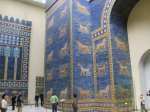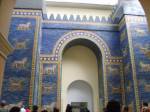Non-Western: The Ishtar Gate
I took these pictures in 2007 at the Pergamon Museum in Berlin, Germany.
I personally consider the Ishtar Gate to be one of the most amazing pieces of architecture in the entire world. I’ve adored it since early childhood, I visited the gate while living in Germany, and I even have a copy of one of the dragons tattooed onto my wrist.
The gate was built around 575 BC by the Babylonian king Nebuchadnezzar II, one of eight to the inner city of Babylon. Nebuchadnezzar II built it in an effort to beautify his capital and as a tribute to the goddess Ishtar. The base of the wall was first excavated by the German archaeologist Robert Koldewey in 1902, and the bricks he uncovered during the excavation have been used to reconstruct the wall in the Pergamon Museum in Berlin, Germany. The giant blue gate is covered in bas-reliefs (dragons, lions, and aurochs) and opens to the Processional Way—a long road bordered by walls that match the gate—which was used in ceremonies and other important events.
The Ishtar Gate is absolutely amazing to behold! The entire gate almost glows—it’s a brilliant glazed blue with white flowers and amazingly detailed bas-relief creatures. One of the creatures is particularly fascinating to me because of the mystery surrounding it: the sirrush/mushhushshu, or dragon. The significance of the dragon has been debated since before the gate was recovered. In some ancient text, including books which did not make it into the modern Bible, the mushhushshu was actually a living create which Nebuchadnezzar II actually kept and forced his people to worship as a living god. Cryptozoologists are particularly encouraged in this possibility by its depiction among known animals. Other scholars assert that the mushhushshu is merely a symbol of the Babylonian god Marduk and was meant as a symbol of divine protection. One of the most interesting hypotheses asserts that the Babylonians got the idea for the mushhushshu from equatorial Africa. It is said that the Congo is home to a dragon known in the region as Mokele-Mbembe. It is believed by some that the Babylonians not only saw this legendary creature of Africa but also captured one and brought it back to the city of Babylon where it was kept in the temple under the command of Nebuchadnezzar II.
I love everything about this gate. It’s beautiful and imposing and has an absolutely fascinating history!
Works Consulted
http://en.wikipedia.org/wiki/Ishtar_Gate
http://www.bible-history.com/babylonia/BabyloniaThe_Ishtar_Gate.htm
http://www.ishtartemple.org/IshtarGate.htm
-
Recent
-
Links
-
Archives
- November 2009 (4)
- October 2009 (3)
- September 2009 (2)
-
Categories
-
RSS
Entries RSS
Comments RSS



